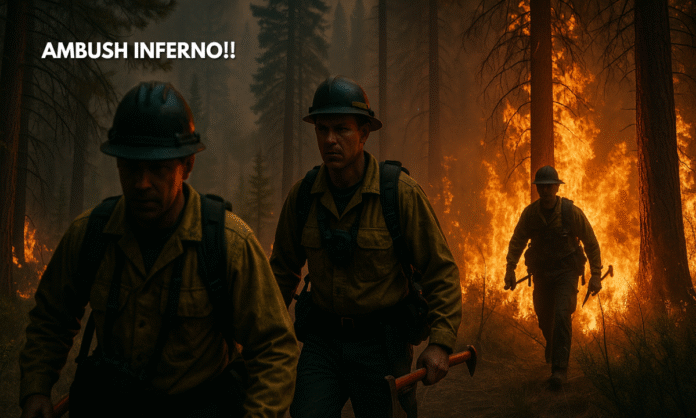Summary
- Two firefighters were killed and one critically injured in a “total ambush” while responding to a brush fire near Coeur d’Alene, Idaho.
- A massive manhunt involving over 300 officers ended with one unidentified shooter found dead with a firearm nearby.
- The incident adds to rising violence against first responders across the U.S., raising concerns about rural security and public trust.
A Brush Fire Turns Deadly: Idaho’s Quiet Landscape Shattered by Gunfire
On the slopes of Canfield Mountain near Coeur d’Alene, Idaho—a region better known for hiking trails and pine-scented stillness—the horror unfolded with military precision. Responding to what seemed like a routine brush fire, three firefighters became the targets of a calculated ambush that left two of them dead and the third “fighting for his life” in a nearby hospital.
The attack stunned local authorities and residents alike, who described the area as “very, very rare” for such violence. Yet this incident now stands as the deadliest known assault on firefighters in the state’s history. More than 300 law enforcement personnel, including FBI and ATF agents, were mobilized in a sweeping operation that spanned dense forests and smoke-filled skies. Tactical helicopters hovered above as SWAT teams combed the terrain, eventually finding one deceased suspect beside a weapon—believed to be the lone gunman.
Kootenai County Sheriff Bob Norris did not mince words, calling it a “total ambush” with “no chance” for the victims. Officials are still unclear whether the man who placed the original 911 call reporting the fire was the attacker himself. The broader question now remains: Was this a targeted attack or the latest grim chapter in the growing epidemic of violence against first responders?
Developing: Evil doesn’t knock anymore. It sets the fire, hides in the brush, then ambushes first responders. Multiple firefighters and officers shot in Coeur d’Alene, Idaho. FBI now involved. This is the time we’re in.🔥 pic.twitter.com/9fxb7uPMQL
— Desiree (@DesireeAmerica4) June 29, 2025
The Unspoken Crisis: Rising Attacks on First Responders in the U.S.
- Over 190 mass shootings have been recorded in the U.S. in 2025 alone.
- Violence against medics and firefighters is rising in both urban and rural areas.
- The Idaho ambush mirrors past incidents like the 2012 Webster, NY shooting, where firefighters were killed responding to a house fire.
- Officials note attackers increasingly use fire as bait to draw in responders.
Firefighters and paramedics have increasingly become targets in the United States. This year, the Gun Violence Archive has tracked over 190 mass shootings, and among them, several have targeted emergency personnel. Just weeks ago in Tulsa, Oklahoma, medics treating a gunshot victim were fired upon by a separate assailant. In Missouri, an ambulance driver was stabbed to death by a patient.
What once felt like isolated anomalies are now coalescing into a disturbing trend. The International Association of Firefighters described the Idaho ambush as “heinous,” warning that even basic rescue missions now carry a rising risk of lethal violence. Incidents like the one in Coeur d’Alene show that the social contract—that first responders are sacrosanct—is dangerously fraying.
The use of fire as bait also mirrors the 2012 attack in Webster, New York, where a gunman lured firefighters to a blaze before killing four. That incident prompted new gun laws in New York, but a nationwide policy shift never materialized. Now, with rural counties also becoming arenas of ambush, the urgency for a federal response may become unavoidable.
Politics, Guns, and the Rural Illusion of Safety
- Idaho officials, including Senators Crapo and Risch, called the event “horrific” and offered prayers.
- Agriculture Secretary Brooke Rollins pledged support from the federal government.
- Rural America is no longer immune to high-powered rifle attacks once stereotyped as urban issues.
- Officials enforced no-fly zones and lifted shelter-in-place orders only after the suspect’s body was found.
The political response to the Coeur d’Alene ambush was swift but restrained. While Agriculture Secretary Brooke Rollins contacted Idaho’s Governor Brad Little and pledged federal support, there has been no immediate discussion of policy reform. Idaho’s Senators—Crapo and Risch—offered “prayers” and urged residents to follow law enforcement orders, but refrained from engaging with the deeper issues of gun access and rural extremism.
The idea that rural America is safer by default has been repeatedly challenged this decade. From mass shootings in small-town churches to sniper attacks on hiking trails, the lines have blurred. The assailant in Idaho reportedly used a high-powered rifle, exploiting the thick brush and mountainous terrain to fire from multiple positions. Sniper fire delayed rescue operations, while heat-seeking drones struggled to differentiate the suspect from civilians and trapped hikers amid the wildfire smoke.
Residents described confusion and disbelief. One 80-year-old local, Linda Tiger, told reporters that she had never witnessed anything like it in her 30 years of living there. “It goes to show no one is safe from this kind of mental sadness,” she said, echoing a sentiment more Americans are now forced to confront.
A Nation Unready for the Fires Within
The Coeur d’Alene ambush marks a turning point—one where America’s escalating gun violence meets its under-resourced rural vulnerabilities. This was not just an attack on firefighters; it was an attack on the very idea of civil rescue. The flames that lured first responders to Canfield Mountain were real, but so was the intent behind them. A deliberate call to kill, cloaked in the guise of emergency.
As the nation mourns yet another preventable tragedy, this one comes with chilling implications: no fire can be assumed innocent, no emergency call neutral. And while law enforcement eventually tracked and neutralized the attacker, the institutional response must go far beyond helicopters and heat sensors.
If rural America continues to deny the creeping reach of weaponized anger, the illusion of safety will burn away—one ambush at a time.


